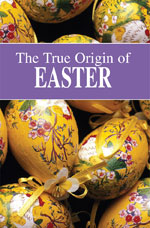 Getty Images
Getty Images
Article
Jesus Christ said He would be in the grave for three days and three nights. Friday afternoon to Sunday sunrise falls far short…
Learn the why behind the headlines.
Subscribe to the Real Truth for FREE news and analysis.
Subscribe NowEvery spring, churchgoers around the world gather on Good Friday evening for candlelight services to commemorate Jesus Christ’s crucifixion. Then, starting at sunrise the following Sunday, they meet again to celebrate the resurrection.
This traditional time period presents a common Bible question: How long was Jesus in the grave before He rose again?
Jesus said in Matthew 12:40, “For as Jonah was three days and three nights in the whale’s belly; so shall the Son of man be three days and three nights in the heart of the earth.”
Taking this at face value, Christ said He would be dead for three days and three nights—72 hours—before His resurrection.
Yet how does that track with Good Friday to Easter Sunday? How do you fit 72 hours between Friday afternoon and Sunday morning? Much of modern Christendom put Christ’s death at around 3:00 p.m. on Friday and His resurrection on Sunday at sunrise, around 6:00 a.m.
This is, at best, only 39 hours—a little over half of the time Jesus said He would be in the grave.
How long was the period between Christ’s death and resurrection? The answer matters more than you think!
Does 1 + 1 = 3?
Catholic.com attempts to answer the question of how Friday evening to Sunday morning equals three days and nights. Their explanation is similar to those across Protestant denominations.
“Is there a contradiction here? No, because the ancient Jews counted as a whole day any part of a day, so ‘three days and three nights’ (which means the same as ‘three days’ in modern usage) could be as little as twenty-four hours plus a few seconds on either side—if there had been, back then, clocks that could register seconds.
“In our way of reckoning things, from lunch time today to lunch time tomorrow is one day. Ancient Jews would have counted it as two days because it includes parts of two distinct days.”
So, the thinking goes, Friday evening is counted as a whole day—Saturday is counted as a whole day—and Sunday morning is counted as a whole day. Many other churches explain this the same way, stating that “ancient Jews” considered parts of days as entire days. But no one brings actual historical evidence that this was the case in first-century society.
This interpretation brings out many logic problems. First, it contradicts Jesus Christ’s own words. He said specifically three days and three nights. Both those words are present in the original Greek!
Let’s illustrate the point using a classic Easter candy: If you were promised three jellybeans, but you only receive one and a half, you would feel slighted. You would be missing half the amount you were offered.
The same is true here. Christ promised He would be in the grave three full days and three full nights—not three portions of days and nights.
This is not a petty theological discussion. Correctly understanding how long Jesus was in the grave is vitally important—and reveals awesome characteristics about God.
Notice the context of Matthew 12:40. In verse 38, some of the scribes and Pharisees cornered Jesus and asked Him to give them a sign. Jesus called them out: “An evil and adulterous generation seeks after a sign; and there shall no sign be given to it, but the sign of the prophet Jonah.”
Jesus told these leaders the only sign He would perform was being in the grave for three days and three nights. It is Christ’s one and only sign—He had to get it right!
No…1 + 1 = 2!
The Old Testament further proves Jesus was in the grave three full days and three full nights. Jesus tied His one sign to the story of Jonah being swallowed by a giant fish.
Jonah 1:17 says, “Now the Lord had prepared a great fish to swallow up Jonah. And Jonah was in the belly of the fish three days [Hebrew: yom] and three nights [Hebrew: layil].” The words for days and nights here are the same Hebrew words found in Genesis 1:5—“And God called the light Day [yom], and the darkness He called Night [layil]. And the evening and the morning were the first day.” A whole 24-hour period is defined as a day and night!
If we put all these verses together and allow the Bible to interpret itself, it is easy to see that the three days and nights Jonah was in the belly of the fish were full 24-hour days as defined in Genesis. And because the example of Jonah was used to explain how long Jesus would be in the grave, the only answer is that He was buried for a full 72 hours.
This leads to the greatest misunderstanding the world has regarding Christ’s death, burial and resurrection. Since 72 hours absolutely cannot fit between Friday afternoon and Sunday sunrise, the world ignores the provable history of the correct date Christ was crucified. Because they are counting from an incorrect start date (Good Friday), they are forced into rejecting very simple math!
John 19 is the account of Christ’s torture, crucifixion and death. This chapter contains powerful and irrefutable points further proving what day Christ was killed. “When Pilate therefore heard that saying, he brought Jesus forth, and sat down in the judgment seat in a place that is called the Pavement, but in the Hebrew, Gabbatha. And it was the preparation of the Passover and about the sixth hour: and he said unto the Jews, Behold your King!” (vs. 13-14). The Jews on that very day were preparing to keep the Days of Unleavened Bread (a seven-day festival also called Passover in Ezekiel 45:21).
Reading further in the chapter continues to make this clear: “The Jews therefore, because it was the preparation, that the bodies should not remain upon the cross on the sabbath day, (for that sabbath day was an high day,) besought Pilate that their legs might be broken, and that they might be taken away” (John 19:31).
The term Sabbath can be used for both weekly and annual Sabbaths—in this case, it is describing the Holy Day that starts the Passover week (Ex. 12:15-16).
So, Christ died in AD 31 on the day before the First Day of Unleavened Bread—a Holy Day! Merging history with this Bible passage demonstrably proves that Christ was not killed on a Friday prior to the weekly Sabbath, but rather killed on a Wednesday afternoon before the Holy Day that would begin at sunset that evening. He was then resurrected Saturday afternoon, 72 hours later.
The truth of the timing of Christ’s crucifixion and resurrection reveals that God is a Being of incredible precision. Jesus said it would be three days and three nights and God guided this to happen. He also brought about the crucifixion at the same time as the Passover lamb was traditionally killed, revealing Christ as mankind’s Passover lamb, sacrificed for the forgiveness of sins (I Cor. 5:7-8).
There is one more chilling reason we must correctly understand Christ’s death and resurrection, and why the Good Friday to Easter Sunday fiction is dangerous.
It comes down to the words of Jesus: “In vain they do worship Me, teaching for doctrines the commandments of men” (Matt. 15:9).
Realize the magnitude of these words: By following “the commandments of men,” a person can unknowingly be worshipping God in vain. No one wants to be in such a position!
Just as God is precise in bringing events to pass, He is also precise in what He desires from those who follow Him—for example, which days you should commemorate. This understanding is plainly laid out in the Bible.
The truth about Christ’s death and resurrection is just one of many issues that bear examination in the Easter season. To learn about Easter’s origins, read our booklet The True Origin of Easter. To learn what days God wants Christians to keep today, read God’s Holy Days or Pagan Holidays?



